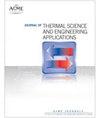Effect of rarefaction on thermal and chemical non-equilibrium for Hypersonic flow with different enthalpy and catalytic wall conditions
IF 1.4
4区 工程技术
Q3 ENGINEERING, MECHANICAL
引用次数: 0
Abstract
Compressibility and rarefaction effect plays an essential role in the design and study of objects experiencing hypersonic flows. The presence of chemical and thermal non-equilibrium in hypersonic flows increases the complexity of estimating aerothermodynamic properties, which are essential for developing thermal protection systems and the aerothermodynamic design of hypersonic vehicles. In this study, the hy2Foam solver, is used to understand the effect of Knudsen number (which in turn depends on the altitude) and free-stream enthalpy variation on the surface aerothermodynamic properties such as pressure, heat flux, velocity slip, temperature jump, and flow-field variables such as species concentration and temperature, in five-species air flow over a cylinder, for both noncatalytic and fully catalytic wall condition. The novelty of the work lies in reporting the effect of rarefaction on thermal and chemical non-equilibrium (associated with hypersonic flows), and thus on the surface properties under different enthalpy and wall catalytic condition. It has been shown the rarefaction effect is more pronounced on the vibrational temperature component, and for high enthalpy gas. The surface wall heat flux and the chemical reaction rate among the species decrease with rarefaction. The skin friction coefficient is one of the most sensitive properties, while the pressure coefficient has been the least susceptible to non-equilibrium effects. The stagnation points heat flux at different Knudsen numbers shows good agreement with the existing correlation in literature for low and high enthalpy flows, which further establishes the validity of the study done in this work.不同焓和催化壁条件下,稀薄对高超声速流动热化学不平衡的影响
可压缩性和稀薄效应在高超声速流动物体的设计和研究中起着至关重要的作用。高超声速流动中化学非平衡和热非平衡的存在增加了气动特性估计的复杂性,这对于开发热防护系统和高超声速飞行器的气动设计至关重要。在本研究中,hy2Foam求解器用于了解在非催化和全催化壁面条件下,在气缸上的五种空气流动中,Knudsen数(反过来取决于海拔高度)和自由流焓变化对表面空气热力学性质(如压力、热流密度、速度滑移、温度跳变)和流场变量(如物质浓度和温度)的影响。这项工作的新颖之处在于报告了稀薄对热和化学不平衡(与高超声速流动有关)的影响,从而影响了不同焓和壁面催化条件下的表面性质。结果表明,对振动温度组分和高焓气体的稀薄效应更为明显。表面壁热流密度和物种间的化学反应速率随稀薄度的增大而减小。表面摩擦系数是最敏感的特性之一,而压力系数对非平衡效应的影响最小。不同Knudsen数处的滞止点热流密度与文献中已有的高低焓流相关关系吻合较好,进一步证明了本文研究的有效性。
本文章由计算机程序翻译,如有差异,请以英文原文为准。
求助全文
约1分钟内获得全文
求助全文
来源期刊

Journal of Thermal Science and Engineering Applications
THERMODYNAMICSENGINEERING, MECHANICAL -ENGINEERING, MECHANICAL
CiteScore
3.60
自引率
9.50%
发文量
120
期刊介绍:
Applications in: Aerospace systems; Gas turbines; Biotechnology; Defense systems; Electronic and photonic equipment; Energy systems; Manufacturing; Refrigeration and air conditioning; Homeland security systems; Micro- and nanoscale devices; Petrochemical processing; Medical systems; Energy efficiency; Sustainability; Solar systems; Combustion systems
 求助内容:
求助内容: 应助结果提醒方式:
应助结果提醒方式:


